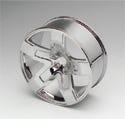July 5, 2007
Originally Published MPMN July/August 2007
BREAKTHROUGHS
Process Combines Two Methods for Faster, More-Durable Prototypes
|
A product design method combines metal cladding and stereolithography to create a new approach to rapid prototyping and short production runs of metallic parts. |
DSM Somos is spearheading a new approach to rapid prototyping and short production runs of metallic parts. The process, called Metal Clad Composite (MC2), combines two technologies—electrodeposition of a copper-nickel composite coating (called a cladding) to plastic and stereolithography (SL). A company called RePliForm Inc. is using MC2 to produce metal-like parts that are strong and durable.
The cladding gives the part performance and durability that is much closer to solid metal than can normally be achieved through SL, according to the company. As a result, engineers can design and test the performance of metallic parts under real-world conditions for longer cycles than possible with uncoated SL parts. They also save time since SL composite prototypes and short production runs can be created faster than machined or die-cast parts in many cases.
|
Tests indicated that nickel-plated stereolithography (SL) parts had more than six times the impact strength and double the heat deflection temperature of nonplated SL parts. |
The two-step process begins when an SL machine washes reaptedly over a grid with liquid UV-sensitive resin. A laser is used to solidify each layer according to the original design, and the object takes shape as each layer is printed onto the previous one. The additive process allows the part to have more-complex geometries and thinner walls than subtractive methods such as machining, where material is taken away from a solid piece in the building process.
The second part of MC2 is adding the copper and nickel cladding. Once the shape is created with SL, all surfaces are prepped for adhesion with a special wash that places ions onto the plastic. A thin layer of copper is applied by dipping the plastic model in a bath.
Once dry, the nickel layer is applied to the specified thickness. The copper layer is used to give the nickel something to bond with electrically, since it does not adhere well to plastic.
Neither of these processes is new. What is new is that RePliForm has created a way to make metal plating work better with SL, creating a true composite coating. The composite increases the durability of the parts.
An MC2 provider can work with a design engineer to determine the appropriate metal thickness for an application, and to make sure that the SL files are modified in such a way that when the metal cladding is added, the final part will meet design tolerances.
DSM Somos, Elgin, OH
www.dsmsomos.com
RePliForm, Baltimore, MD
www.repliforminc.com
Copyright ©2007 Medical Product Manufacturing News
You May Also Like




